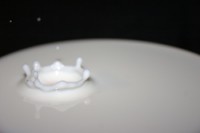How to Prolong the Life of Your Perishables
 As the weather heats up, it means that perishables will also be facing shorter lives than usual with an increased of bacterial growth.
As the weather heats up, it means that perishables will also be facing shorter lives than usual with an increased of bacterial growth.
Combating the accelerated ageing of your perishables is easy and only requires a few simple steps. Always keep in mind, however, that you should always observe the best before or use by date.
Seal
When you open any perishable for the first time, it’s important to try and seal them closed again as tightly and with as little air as possible. While certain perishables won’t be as heavily affected by air getting in, the likes of bread and biscuits will go stale earlier if exposed to air for too long.
For perishables such as milk, the biggest issue is heat. The longer milk is exposed to hot temperatures, the more bacteria will form and cause it to go off. So make sure you keep your milk refrigerated at all times.
When certain perishables go off, they may not necessarily have any severe health impacts as others. For example, if you happen to have soft drink that goes past its best before date, it could taste odd but won’t necessarily make you ill. But if you notice any odd taste, it’s best to throw it out.
Old bread will form mould and should not be eaten under any circumstances. Products like milk will have use by dates. If it goes past the use by date, you should no longer consume it as formed bacteria could cause you to become sick. You can usually tell milk is off due to a strong smell, odd texture or unpleasant taste. If your milk tastes off, do not drink anymore. Throw it away and buy a new batch.
Airtight
As mentioned before, sealing many of your perishables to be airtight is a good idea. If perishables such as biscuits aren’t kept in airtight containers they can go off before the actual best before/use by date outlined on the packaging. This is usually characterised through staleness (with crackers) or softness/stickiness (with biscuits).
While keeping products in airtight containers may not prolong their life, it will ensure that their shelf life isn’t shortened in respect to its projected shelf life.
Freezer
For perishables such as meats, the freezer can be a great way to give them a much longer life than originally intended. This is because freezing essentially stops or significantly slows down the ageing process of perishables. Other perishables can be frozen, but for the most part meats are one of the more logical perishables to freeze.
Just be cautious about thawing out meats once you’ve removed them from the freezer. For one, removing them from the freezer and immediately thawing them out room temperature – especially during summer – can cause bacteria to quickly form and post health concerns. The best approach is to initially thaw your meat out in your fridge for at least 24 hours, then allow for a little room temperature thawing before cooking.
The difference between “best before” and “use by” dates
There has often been a bit of ambiguity around what the exact difference between “best before” and “use by” is. That said, this ambiguity has often been due to a lack of clarification, as the actual difference is very simple.
“Best before” simply denotes that the product will be in its best condition prior to the associated date. After that date, it may still be fine to consume, but its quality could’ve depreciated. It’s a good idea to have the rest of your product within a day or two after the “best before” date.
“Use by” is used to denote products that must be consumed by the associated date. If you do not consume your product before or by the use by date, then it is highly suggested that you throw it out as consuming it after this date could lead to food poisoning and sickness due to bacterial growth.
Are there any other safe ways to prolong the life of perishables that we’ve missed? Share them with us in the comments below.